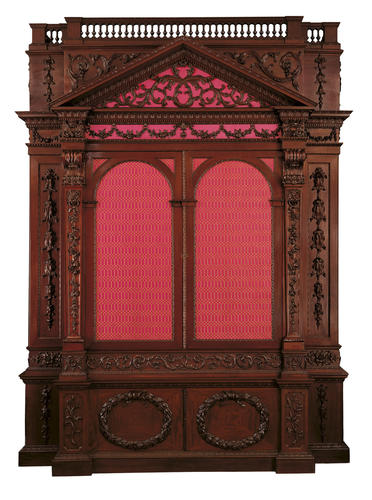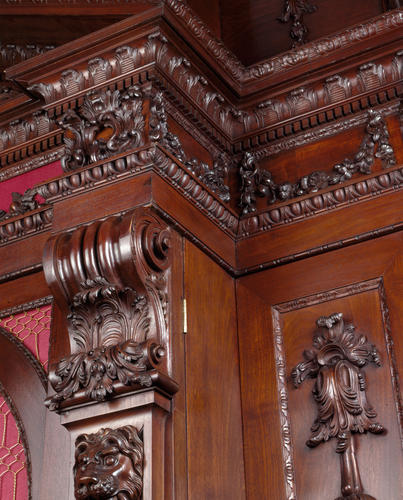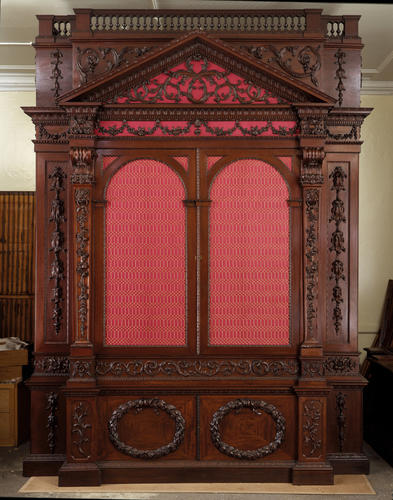Organ cabinet c.1745-63
Carved and turned mahogany | 346.0 x 259.0 x 107.0 cm (whole object) | RCIN 1366
-
An upright mahogany organ cabinet of breakfront form with applied carved detail; a balustraded gallery on top with a pediment below, two glazed and trellis doors with arched tops, lined with silk; lower doors with wreaths; foliate scroll carving applied on frieze.
The strongly Palladian form of this cabinet lends support to the generally held theory that it may originally have been made in the 1740s, either for George II or (perhaps more likely) for Frederick, Prince of Wales. If this was the case, Benjamin Goodison, as principal cabinet-maker to the Great Wardrobe and to the Prince and Princess of Wales, was highly likely to have been involved in its manufacture. Its large and unusual form reflects its purpose, which was to house an upright harpsichord and organ (claviorgan). The Prince and Princess of Wales, who were passionately fond of music, had a number of organs at Leicester House and Carlton House, including at least two 'machine' or mechanical organs. Organ cases there were regularly cleaned and polished by Goodison; and payments for mechanical work are recorded to John Pyke in the 1740s and to George Pyke and John Snetzler in the 1760s. In 1763 Christopher Pinchbeck was paid for substantial alterations to the 'Great Organ' (evidently a 'machine organ') at Carlton House. This included the preparation of '23 Large Barrels'.
There is, however, nothing in the Great Wardrobe or Duchy of Cornwall accounts which can with any certainty be identified with this object, either in its original or its adapted form. Furthermore, William Vile's bill for 'Altering the Organ and upright Harpsichord' for the Japan Room in the Queen's House, often cited in connection with this organ cabinet, can only with some difficulty be made to match the cabinet as it exists today. The removal (at some point in the nineteenth century) of all trace of the original machinery from the interior has further complicated the picture, although cuts and old fixings in the framework indicate where keyboard, pedals and stops were once located.
Vile's bill of 1763 describes the substantial reconstruction for Queen Charlotte of the cabinet of an existing organ and upright harpsichord (or claviorgan) - conceivably from Carlton House - and the addition of considerable quantities of new carving. The latter included 'Ovals of laurel' and 'Vinetree Ornaments', which are among the few elements on this piece that match this bill (although with no trace of the gilding mentioned therein) and which, together with the vigorously carved drops of flowers and foliage, compare in style and technique with the carving on the bookcase, made by Vile for Queen Charlotte in the 1760s. In 1763 the organ cabinet which Vile had modified was replaced in the Japan Room at Buckingham House with a 'very grand' new organ cabinet, supplied by his successor John Bradburn at a cost of £392 12s; Bradburn's organ is probably that shown in Stephanoff's view of 1817. The claviorgan was presumably then moved to the Queen's Gallery at Kensington Palace where it is shown with some of the matching set of cabinets in a view of that room, also by Stephanoff, published in 1819. A year later the organ and cabinets were refurbished at the Prince Regent's request by France and Banting and in June 1820 the 'Large Organ belonging to the King' was noted at Kensington Palace in a list of the late King's property.Provenance
Probably made for Frederick, Prince of Wales in 1745; altered for George III 1763.
-
Creator(s)
(nationality)Acquirer(s)
-
Medium and techniques
Carved and turned mahogany
Measurements
346.0 x 259.0 x 107.0 cm (whole object)












